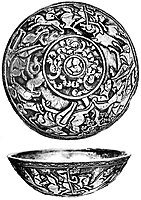Hephthalite silver bowl
Appearance
| Hephthalite silver bowl | |
|---|---|
| Present location | British Museum, London |
| Registration | 1963, 1210.1 |
The Hephthalite silver bowl is a bowl discovered in the
Alchons
.
Description
The bowl is dated to 460-479 CE, at the end of Kidarite rule and the beginning of Alchon ruler in northwestern India, although slightly earlier dates have also been suggested.[3][4][5]
The bowl represents a groups of four noble figures on horse, in the process of hunting animals. Despite its former attribution to the "
skull deformation, one of the Alchons reappearing in portrait inside a medallion at the bottom of the bowl. This combination of two different Huna tribes in the same work of art suggests a period of peaceful coexistence between the Kidarites and the Alchons, who may have each been in control of their own territory, although the Alchons would eventually replace the Kidarites in Gandhara.[5] This understanding of the iconography of the Hephthalite silver bowl is the result of a general scholarly consensus.[6]
At one point, the Kidarites withdrew from Gandhara, and the Alchons took over their territory and their mints, from the time of
Khingila.[3] By 520, Gandhara was definitely under Hephthalite (Alchon Huns) control, according to Chinese pilgrims.[7]
Inscription
The bowl contains an inscription in
Khingila.[8] The comparison with the Brahmi lettering for his name on the later coinage of Khingila indeed may suggest that the name Khingila is intended in the vase inscription, even though the dot-by-dot engraving is rather clumsy and does not perfectly match standard typography.[8]

Views
-
Bowl in full
-
Alchon horseman
-
Alchon horseman
-
Kidarite horseman
-
Kidarite horseman
Other examples
Alchon Hun
ruler in the central medallion.Other examples of very similar silver bowls have been found in the area of
The man in the medallion at the bottom of the Chilek bowl has a clearly elongated skull, characteristic of the Alchons Huns.[12]
See also
Wikimedia Commons has media related to Hephthalite silver bowl.
- Sasanian (or later) silver bowl, 7th-8th century CE[13]
- Shallow bowl, probably Afghanistan, Sasanian period, 5th-7th century CE, silver, gilt
References
- ^ British Museum notice
- ISBN 978-0-87099-248-3.
- ^ ISSN 0078-2696.
- ISBN 978-0-300-09038-3.
- ^ ISBN 978-94-93194-00-7.
- ISBN 978-94-93194-00-7.
- ^ The Huns, Hyun Jin Kim, Routledge, 2015 p.50 sq
- ^ ISBN 978-94-93194-00-7.
- ISSN 0012-8376.
- ^ Kurbanov, Aydogdy (2014). "The hephthalites: iconographical materials" (PDF). Tyragetia. VIII [XXIII]: 328.
- ISSN 0890-4464.
- ISBN 978-94-93194-00-7.
- ^ Ancient Iranian metal art (PDF). Arthur M. Sackler Gallery. pp. 165–168.









